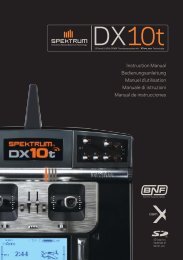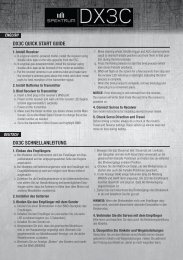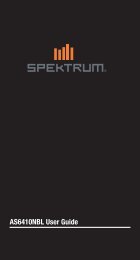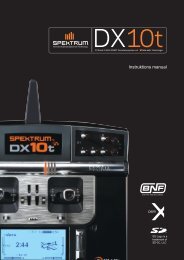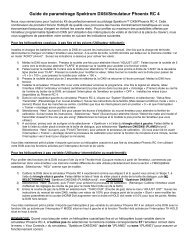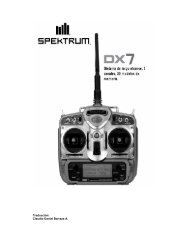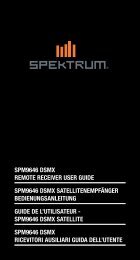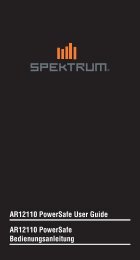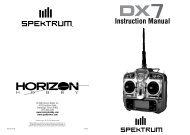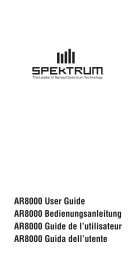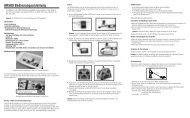6-Channel 10-Model Memory Full Range DSM2™ 2.4GHz Radio ...
6-Channel 10-Model Memory Full Range DSM2™ 2.4GHz Radio ...
6-Channel 10-Model Memory Full Range DSM2™ 2.4GHz Radio ...
Create successful ePaper yourself
Turn your PDF publications into a flip-book with our unique Google optimized e-Paper software.
RECEIvER POwER SySTEM REqUIREMENTS<br />
With all radio installations, it is vital the onboard power system provides adequate power without interruption<br />
to the receiver even when the system is fully loaded (servos at maximum flight loads). This becomes especially<br />
critical with giant-scale models that utilize multiple high torque/ high current servos. Inadequate power systems<br />
that are unable to provide the necessary minimum voltage to the receiver during flight loads have become the<br />
number-one cause of in-flight failures. Some of the power system components that affect the ability to properly<br />
deliver adequate power include: the selected receiver battery pack (number of cells, capacity, cell type, state of<br />
charge), switch harness, battery leads, regulator (if used), power bus (if used).<br />
While Spektrum’s receivers’ minimum operational voltage is 3.5 volts, it is highly recommended the system<br />
be tested per the guidelines below to a minimum acceptable voltage of 4.8 volts during ground testing. This<br />
will provide head room to compensate for battery discharging or if the actual flight loads are greater than the<br />
ground test loads.<br />
RECOMMENDED POwER SySTEM GUIDElINES<br />
1. When setting up large or complex aircraft with multiple high torque servos, it’s highly recommend that<br />
a current and volt-meter (Hangar 9 HAN172) be used. Plug the volt-meter in an open channel port in<br />
the receiver and, with the system on, load the control surfaces (apply pressure with your hand) while<br />
monitoring the voltage at the receiver. The voltage should remain above 4.8 volts even when all servos<br />
are heavily loaded.<br />
Note: The optional Flight Log has a built-in volt meter and it can be used to perform this test.<br />
2. With the current meter in line with the receiver battery lead, load the control surfaces (apply pressure<br />
with your hand) while monitoring the current. The maximum continuous recommended current for a<br />
single heavy-duty servo/battery lead is three amps while short-duration current spikes of up to five<br />
amps are acceptable. Consequently, if your system draws more than three amps continuous or five<br />
amps for short durations, a single battery pack with a single switch harness plugged into the receiver for<br />
power will be inadequate. It will be necessary to use multiple packs with multiple switches and multiple<br />
leads plugged into the receiver.<br />
Note: The Flight log can not measure current draw. Please note that if the flight log is used to<br />
measure voltage, the HAN172 current meter still must be used to measure the draw of the servos.<br />
3. If using a regulator, it’s important the above tests are done for an extended period of 5 minutes. When<br />
current passes through a regulator, heat is generated. This heat causes the regulator to increase<br />
resistance, which in turn causes even more heat to build up (thermal runaway). While a regulator may<br />
provide adequate power for a short duration, it’s important to test its ability over time as the regulator<br />
may not be able to maintain voltage at significant power levels.<br />
4. For really large aircraft or complex models (for example 35% and larger or jets) multiple battery packs<br />
with multiple switch harnesses are necessary or in many cases one of the commercially available power<br />
boxes/ busses is recommended. No matter what power systems you choose, always carry out test #1<br />
above making sure that the receiver is constantly provided with 4.8 volts or more under all conditions.<br />
5. The latest generation of Nickel Metal Hydride batteries incorporate a new chemistry mandated to be<br />
more environmentally friendly. These batteries, when charged with peak detection fast chargers, have<br />
tendencies to false peak (not fully charge) repeatedly. These include all brands of NiMH batteries. If<br />
using NiMH packs be especially cautious when charging making absolutely sure that the battery is fully<br />
charged. It is recommended to use a charger that can display total charge capacity. Note the number of<br />
mAh put into a discharged pack to verify it has been charged to full capacity.<br />
SPEKTRUM DX6i • RADIO PROGRAMMING GUIDE<br />
21



